
Love books? Why not blog about them—and get paid for it. Starting a book blog is more than just sharing reviews; it’s about building a brand, growing an audience, and using smart blogging strategies to turn your passion into profit. This guide shows you how.
What is a Book Blog?
A book blog typically covers things like:
✔ Book reviews (fiction, nonfiction, bestsellers, indie books)
✔ Writing tips (how to write a novel, self-publishing guides)
✔ Author interviews & industry news (publishing trends, book deals)
✔ Reading recommendations (“Best Fantasy Books of 2025”)
Beginner’s Tip: Your blog appears in Google search result, people can find and visit your content and you can monetize your site with display ads and affiliate to make money to make money.
Quick Step to Get You Started
Step 1: Choose Your Book Niche
Pick a specific category like:
- Romance Novels
- Self-Help Books
- Sci-Fi Reviews
Step 2: Get a Domain & Hosting: Use HostGator (affordable & beginner-friendly) to secure your blog’s name and hosting.
Step 3: Access WordPress: It’s free, easy to customize, and great for SEO. You can access WordPress in your HostGator after your signup.
Step 4: Write Helpful Posts: Share book recommendations, reviews, or writing tips—anything your readers will love!
Step 5: Get Traffic: Use SEO + Social Media (Pinterest, Instagram, Reddit) to attract book lovers.
How to Make Money from Your Book Blog
You can earn with:
✔ Google AdSense – $500–$2k/month (with 10k+ visitors)
✔ Amazon Associates – Earn 4-10% on book sales
✔ Sponsorships – $200–$10k per post (from authors/publishers)
✔ Digital Products – Sell eBooks, courses, or printables ($50–$1,500 each)
You don’t need to be an expert—just start, stay consistent, and watch your blog grow!
What You’ll Learn in This Guide
By the end, you’ll:
✅ Have a live book blog ready for your first review
✅ Know exactly what to write about
✅ Understand how to make money from your blog
✅ Learn how to attract readers who love books
You can do this🚀 let’s get started! 📚✨
What You Need to Start Your Book Blog
Here’s what you need to get your blog up and running:
1️⃣ A Laptop or Desktop – You’ll need a computer to manage your blog, write posts, and design your site.
2️⃣ A Domain Name – This is your blog’s web address (e.g., “yourbookblog.com”). Choose something catchy and related to books.
3️⃣ A Blogging Platform – The best option is WordPress.org because it’s easy to use and gives you full control over your blog.
4️⃣ Web Hosting – Hosting keeps your blog online. I recommend HostGator because it’s beginner-friendly and allows easy WordPress installation.
💡 Pro Tip: Once you sign up for web hosting through HostGator, you can install WordPress with one click and start publishing book reviews, discussion posts, and author interviews right away! You can’t use WordPress.org directly as you need web hosting to activate your WordPress, which is what HostGator does.
Affiliate Disclosure: This post may include affiliate links with special discounts. Using them saves you money and supports our site at no extra cost to you. Win-win right! Check out our [Privacy Policy] for more details. Thanks for your support!
How to Start a Book Blog That Makes Money in 9 Easy Steps
For this guide, I’ll walk you through using HostGator, one of the best web hosting services for beginners.
Quick 9 steps to start a book blog that can be monetized.
1️⃣ Step 1: Choose a book-related sub-niche to start from.
2️⃣ Step 2: Sign up for HostGator.
3️⃣ Step 3: Select a hosting plan that fits your budget.
4️⃣ Step 4: Choose and register your domain name.
5️⃣ Step 5: Adjust your hosting subscription period.
6️⃣ Step 6: Create your HostGator account.
7️⃣ Step 7: Install WordPress inside your HostGator account.
8️⃣ Step 8: Pick a theme for your blog (a pre-built site).
9️⃣ Step 9: Customize your pages and start publishing book-related posts.
Step 1: Choose a Book Blog Niche
Before you start, it’s smart to focus on a specific niche within the book blogging world. Instead of trying to cover everything, narrowing down your focus will help you attract a loyal audience and stand out.
Here are some popular book blog niches to consider:
- 📚 Book Reviews – Reviewing books from specific genres (fantasy, romance, thrillers, classics, etc.).
- 📖 Author Interviews & News – Covering author updates, book signings, and exclusive interviews.
- 📕 Literary Analysis – Deep dives into themes, symbolism, and hidden meanings in books.
- 📚 Book Recommendations – Lists like “Best Books for Summer” or “Must-Read Thrillers.”
- 📖 Self-Publishing & Writing Advice – Helping aspiring writers with book marketing and self-publishing.
- 📕 Reading Challenges & Book Clubs – Engaging readers with challenges and discussions.
- 📚 Book Hauls & Collector’s Editions – Showcasing new releases and beautiful editions of books.
💡 Pro Tip: Choose a niche that excites you! A blog requires consistency, so pick a topic that keeps you motivated to write.
Step 2: Click On Our “HostGator” Discount Link
With our discounted hosting plan, you can launch your blog with a free domain name and a smooth website experience for your readers. HostGator makes the process eay for beginners but other reliable web hosting services you can use as well.
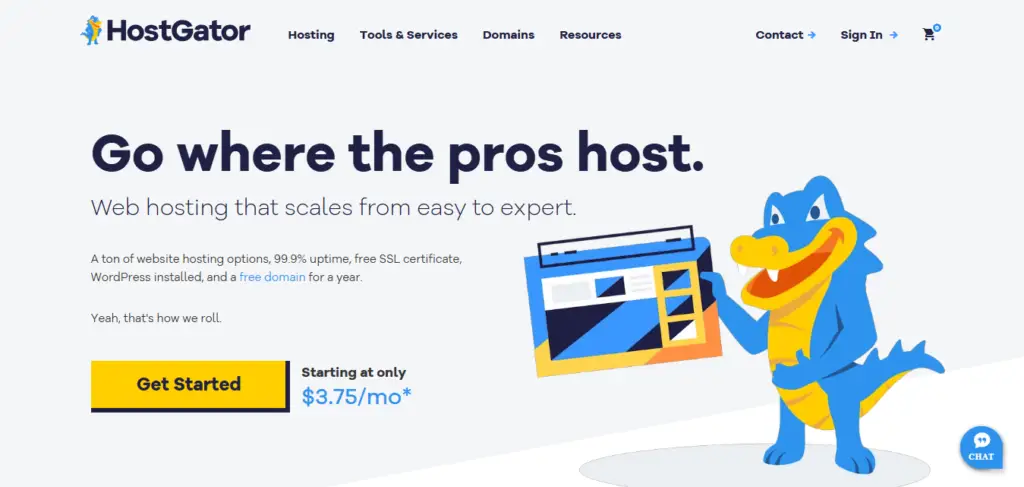
Step 3: Choose Your Preferred HostGator Plan
If you’re looking for an affordable and flexible option, the HostGator Hatchling plan is ideal. You get a solid start, with the freedom to upgrade anytime as your needs increase.
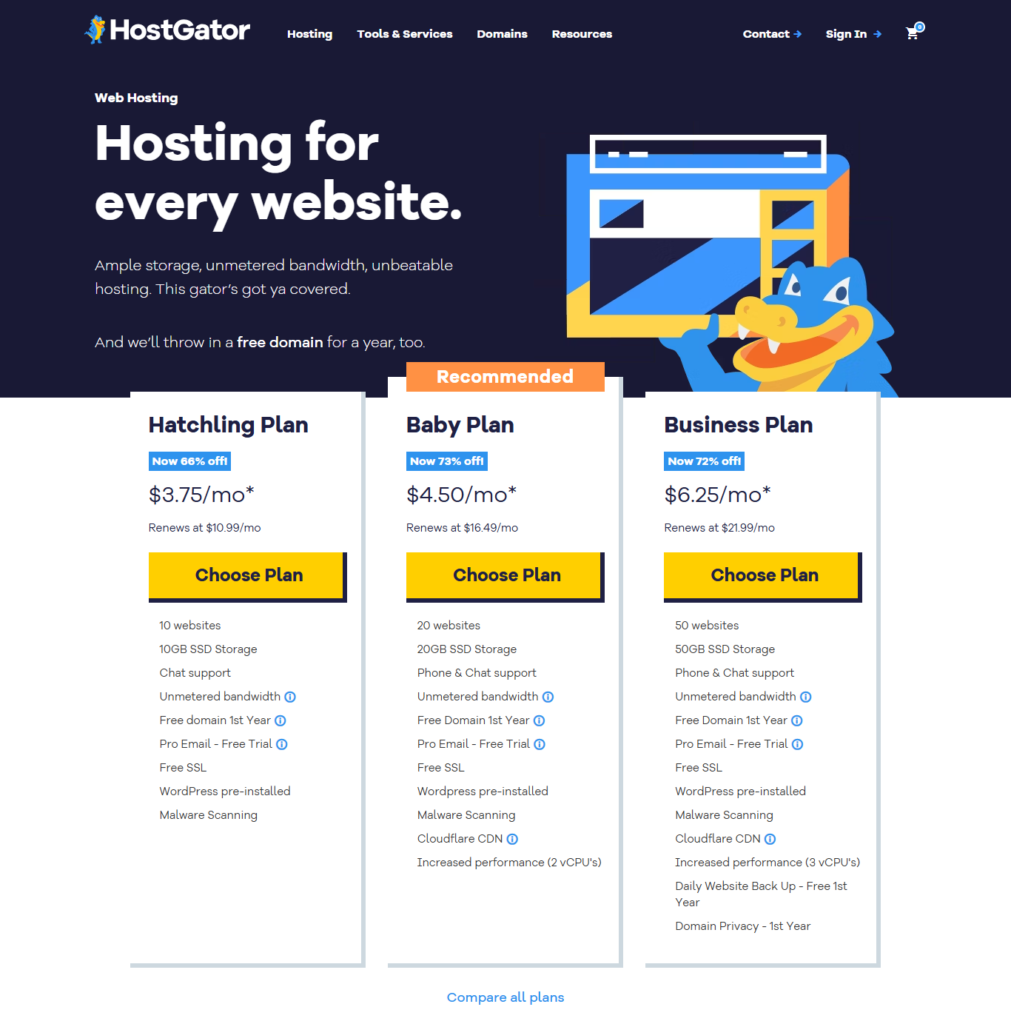
Step 4: Create a Professional Domain Name
Once you’ve chosen your plan above, you’ll be taken to a page like the one below, where you can create a domain name of your choice and complete your sign-up.
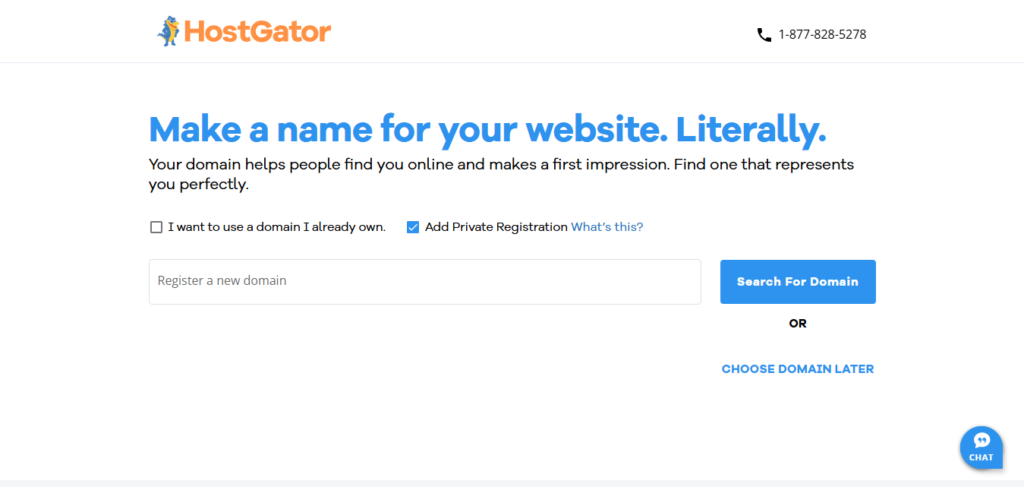
How to choose a good name for your literature blog
- 📚 Make it Literary & Engaging – Consider names like PageTurnerReviews.com or BibliophileCorner.com that immediately signal books.
- 📖 Reflect Your Niche – If you focus on fantasy books, self-help books, or book summaries, incorporate that (e.g., FantasyShelf.com or NonFictionDigest.com).
- 📝 Keep it Short & Readable – A domain like TheLitShelf.com is far better than AllMyThoughtsOnBooksAndReading.com.
- 🔊 Easy to Say & Spell – Avoid tricky words that could be mistyped (LiteraryXtravaganza.com is harder to spell than BookHaven.com).
Find unique and meaningful blog name ideas
Step 5: Select the Subscription Period You Want
Choose the Hatchling Plan on the left, and pick a subscription length—either 1 year or 36 months—depending on what fits your budget best.
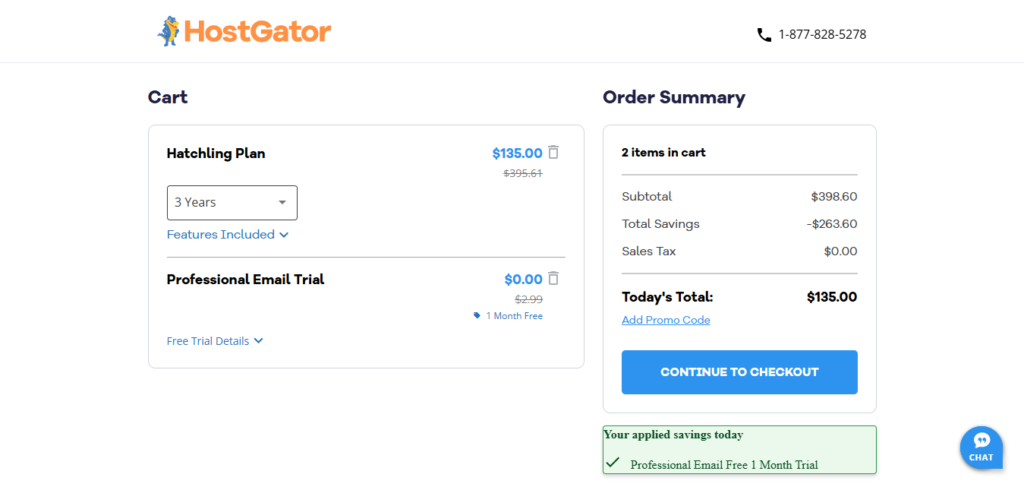
Step 6: Create your HostGator account
Complete your account creation by entering your personal details and choosing a secure password
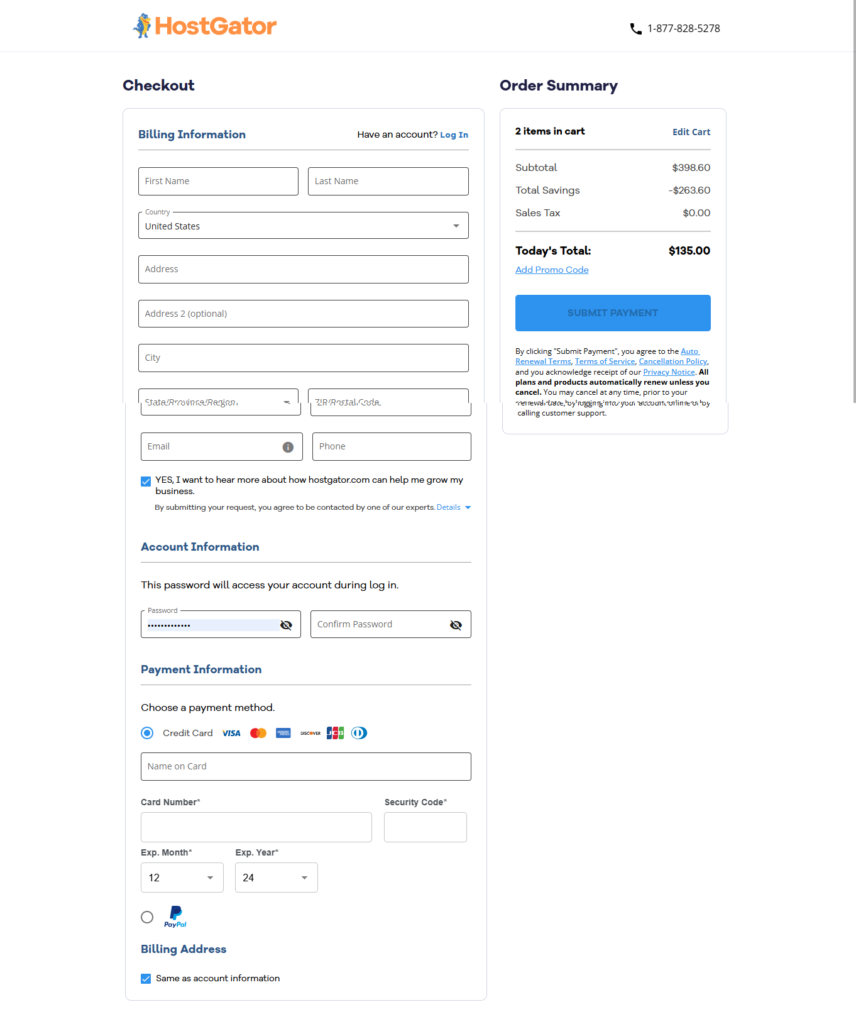
Step 7: Install WordPress on HostGator
- After signing up, HostGator will guide you to install WordPress—just follow the on-screen steps.
- Alternative: You can log in into your HostGator account go to the “Websites” or “WordPress” section, and click to install.
- You’ll be logged into WordPress where you’ll start publishing blog posts and manging your site.
Step 8: Pick a Design for Your Book Blog (Easy Guide!)
Your blog’s theme is like its outfit—it changes how it looks without changing the content. Here’s how to pick the perfect one:
1. Find the Theme Menu
- Go to your WordPress dashboard
- Hover over “Appearance” → Click “Themes”
2. Browse Free & Paid Themes
- Use the search bar (try “book blog” or “minimal blog”)
- Filter by popular features like:
- Grid layouts (great for book covers!)
- Mobile-friendly (must-have!)
- Social media buttons (for sharing reviews)
3. Preview Before You Choose
- Hover over a theme → Click “Preview”
- Check how it looks on phones & tablets (many readers use mobile!)
4. Look for These Key Features
✔ Easy to customize (colors, fonts, etc.)
✔ Fast loading (no one likes a slow blog!)
✔ Good reviews (check ratings before installing)
5. Free vs. Paid?
- Free themes are great for beginners!
- Paid themes offer extra features, but you don’t need them right away.
💡 Pro Tip: Start simple! You can always change your theme later.
Find some of the best WordPress themes for your book blog.
Step 9: Make Your Blog Unique & Start Posting!
✨ Personalize Your Blog’s Look
- Go to Appearance → Customize in WordPress
- Play with:
- Colors (pick ones that match your book niche!)
- Fonts (easy-to-read styles work best)
- Layout (clean & simple is perfect for book blogs)
📄 Set Up Key Pages (Super Easy!)
Your theme includes ready-made pages – just fill them in:
- Homepage – Show off your latest book reviews
- About Page – Tell readers who you are & why you love books
- Contact Page – Let authors/publishers reach you
✍️ Time to Write Your First Post!
Start with something simple like:
- “My Top 5 Favorite [Genre] Books This Month”
- “Honest Review: [Book Title] – Worth Reading?”
- “Beginner’s Guide to [Your Niche] Books”
💡 Pro Tip:
- Use bold headings & short paragraphs – easier to read!
- Add book cover images (makes posts more engaging)
Your blog is ready to shine! Keep posting regularly and your audience will grow. 🚀📖
Congratulations! You’ve now set up a fully functional blog and are ready to start sharing your thoughts with the world. Your site is live and accessible on Google and everywhere online!
Find Profitable Blog Post Ideas For Your Book Blog
A book blog can be highly profitable if you focus on SEO-driven traffic and strategic monetization.
Below, we break down high-value post ideas into traffic builders (ad revenue) and affiliate/conversion posts (direct earnings).
1. Types of Blog Posts to Target
These attract engaged readers and rank well on Google/Pinterest.
📚 Book Recommendations & Lists (Evergreen Traffic)
- “50 Must-Read Books of 2025 (Fiction & Nonfiction)”
- “Best Fantasy Series to Binge-Read This Year”
- “Classic Books That Still Hold Up Today”
SEO Tip: Target long-tail keywords like “best books for [mood/occasion].”
📖 Genre-Specific Guides
- “Dark Academia Books: The Ultimate Reading List”
- “Cozy Mystery Novels Perfect for Rainy Days”
- “Best Thrillers With Unpredictable Endings”
🎭 Author Spotlights & Interviews
- “Exclusive Interview With [Author]: Behind Their Latest Bestseller”
- “Underrated Authors You Should Be Reading”
Pro Tip: Partner with publishers for early review copies.
2. Affiliate & Revenue-Generating Topics
You can make money through comissions by promtoing book sales, subscriptions, and literary services.
💰 Book Roundups & Gift Guides
- “Best Books to Gift for Christmas 2025” (Amazon, Bookshop.org affiliate links)
- “Book Subscription Boxes Worth the Hype” (Book of the Month, OwlCrate affiliate links)
- “Best Kindle Deals This Week” (Time-sensitive = urgency)
Must Include:
✔ Price comparisons
✔ Personal reviews
✔ Exclusive discount codes
📖 Book Reviews (In-Depth & Honest)
- “[Book Title] Review: Why It’s Worth the Hype”
- “Is [Popular Book] Overrated? My Honest Take” (Controversial = engagement)
Monetization Hack: Use Amazon Associates for the highest conversions.
🎓 Literary Courses & Resources
- “Best Online Writing Courses for Aspiring Authors” (MasterClass, Udemy affiliate links)
- “Must-Have Tools for Book Lovers” (Goodreads, StoryGraph affiliate links)
Find Different Topics: Book Blog Topic Ideas
3. Softwares to Boost Efficiency
- Goodreads – Track reading progress & generate lists
- Canva – Design quote graphics for Pinterest
- Bookly – Organize review schedules
Looking for help with your writing?
4. Monetization Timeline
- 0-3 Months: Focus on 5-10 detailed book lists/reviews (build authority).
- 3-6 Months: Add affiliate roundups & gift guides (income streams).
- 6+ Months: Pitch publisher sponsorships (early review copies, paid features).
Find more detaile here: How long it typically takes to make money blogging and why
How to Make Money with Your Book Blog
If you run a book blog, you already know how rewarding it is to share your literary passion. But did you know you can also turn your blog into a steady income stream?
By leveraging strategies like display ads and affiliate marketing, you can earn money while discussing your favorite books and authors.
1. Monetize Your Book Blog with Display Ads
One of the fastest way to start making money from your book blog is through Google AdSense. Once set up, ads run automatically, earning you money while you focus on your creating content.
How to Set Up Google AdSense for Your Book Blog
Step 1: Sign Up for Google AdSense
- Visit Google AdSense and click “Sign Up.”
- Use your existing Google account.
- Submit your blog’s URL and basic info. Google will review your site (approval usually takes a few days).
- Pro Tip: Having at least 10-15 high-quality book reviews or literary posts improves approval chances.
Step 2: Add AdSense Code to Your Blog
- Once approved, paste the provided code into your blog’s HTML.
- Place ads in high-visibility spots, such as:
- Sidebar (near your book recommendations).
- Within posts (after a book review).
- Header or footer.
- WordPress users can simplify this with plugins like Ad Inserter.
Step 3: Start Earning from Ads
- Google displays relevant ads (e.g., book retailers, Kindle deals, literary subscriptions).
- You earn through clicks (CPC) or impressions (CPM).
- The best part? Ads work automatically, requiring minimal maintenance.
How Much Can Book Bloggers Make from Ads?
Earnings depend on traffic volume and niche engagement. New bloggers might earn $200–$500/month, while established book blogs with strong traffic can make $1,000–$5,000/month.
Want to boost earnings? Learn how to increase your blog visitors’ pageviews and improve retention time to maximize ad revenue.
For more inspiration, check out real blog income reports from real bloggers.
2. Monetize with Affiliate Marketing (Book Recommendations)
Affiliate marketing is a perfect fit for book blogs—you already recommend books, so why not earn commissions when readers buy them?
Best Affiliate Programs for Book Bloggers
- Amazon Associates – Earn 4-10% on book sales (physical, Kindle, audiobooks).
- Bookshop.org – Supports indie bookstores; 10% commission.
- Audible (Amazon) – Earn $5-$15 per new Audible membership.
- Barnes & Noble Affiliate Program – Competitive rates on book sales.
- Kobo Affiliate Program – Great for ebook and audiobook promotions.
For more options, see our guide to the best high-paying affiliate programs for book bloggers.
How to Promote Affiliate Links Effectively
- Honest Book Reviews – Include affiliate links to purchase the book.
- Monthly Reading Wrap-Ups – Link to all the books you read that month.
- Gift Guides – “Best Fantasy Books for Beginners” or “Must-Read Thrillers.”
- Comparison Posts – “Kindle vs. Kobo: Which E-Reader is Best?”
How Much Can You Earn from Affiliate Marketing?
- Beginners: $100–$500/month.
- Established blogs: $1,000–$10,000/month (especially with high-traffic book lists).
For more insights, here on “how long it will take you to start making money from your blog“ and “how many posts you need before earning“.
Bonus: Other Ways to Monetize a Book Blog
- Sponsored Reviews – Publishers may pay for featured book spotlights.
- Selling Digital Products – eBook guides, reading journals, or book club kits.
- Membership or Patreon – Offer exclusive content for dedicated readers.
- Online Courses – Teach “How to Start a Book Blog” or “Speed Reading Tips.”
For more ideas, explore [other ways to make money from your book blog].
Final Thoughts on Monetization
Monetizing a book blog is totally doable with the right strategies. Start with Google AdSense and affiliate links, then expand into sponsorships or digital products as your audience grows.
Here is a Realistic Income Report.
How to Get Readers to Your Book Blog
The reality? Even the most insightful book content won’t gain traction without promoting your blog strategically. To build a thriving community of book lovers, you need a plan that combines search engine visibility and social engagement.
Want more readers who love books as much as you do? Forget quick fixes—these two proven strategies will bring steady traffic and loyal fans to your book blog for years to come.
1. SEO: Get Found by Book Lovers (For FREE!)
Search engines send readers straight to your blog—if you optimize for them. Here’s how:
🔍 Find What Readers Are Searching For
Use these keyword research tools to discover book-related keywords:
- Google Keyword Planner (free)
- Ubersuggest (affordable)
- AnswerThePublic (reveals reader questions)
Target high-intent keywords like:
✅ “Best fantasy books for adults 2025” (instead of just “fantasy books”)
✅ “Books like The Midnight Library”
✅ “How to read 50 books a year”
📌 Pro Tip: Long-tail keywords bring better traffic—readers already know what they want!
📝 Write Content That Ranks (And Keeps Readers Hooked)
- Book lists (“27 Must-Read Thrillers You Can’t Put Down”)
- Reader problem-solvers (“How to Remember What You Read”)
- Author deep-dives (“Why Jane Austen’s Books Still Matter Today”)
🚀 On-Page SEO Checklist
✔ Optimize images (compress book covers, use descriptive filenames)
✔ Internal linking (connect related posts—“If you liked this, check out our mystery recs!”)
✔ Fast loading speed (slow blogs = lost readers)
✔ Schema markup (helps Google show star ratings for your reviews)
📖 Want the full guide? Grab our Free Book Blog SEO Checklist.
2. Social Media & Community Engagement (Build a Loyal Fanbase)
SEO brings traffic—social media brings superfans. Here’s how to connect:
📢 Best Platforms for Book Bloggers
- Pinterest (Ideal for book lists—“Pin-friendly” graphics perform best)
- Promote on Instagram (Behind-the-scenes reading life, Reels of book hauls)
- Book Twitter (X) / Bookstagram (Join reading challenges, #BookTwitter discussions)
- Goodreads (Review books, join groups, link back to your blog)
💬 Engage, Don’t Just Promote
- Comment on other book blogs (genuine engagement > spammy links)
- Start a reading challenge (“Read 12 Classics in 2025”)
- Host a book giveaway (Boost shares & followers)
📌 Pro Tip: Repurpose content! Turn a blog post into a Twitter thread, Instagram carousel, or Pinterest pin.
Final Tip: Consistency Wins
🚀 SEO + Social Media = Unstoppable Growth
- Post 1-2 blog posts weekly (quality over quantity!)
- Engage daily on 1-2 platforms (better than being everywhere but inactive)
Bonus Tip to boost traffic:
✍️ Guest Posting (Get Backlinks & Authority)
📊 Use Google Analytics to Track Your Blog Traffic
Keep an eye on how visitors find your blog by monitoring key traffic sources like search engines (SEO), social media, and referral links from other websites. This helps you see what’s working—and what to improve.
🛠 Must Have Blogging Tools: Best Blogging Tools for Book Bloggers.
Simplified Summary
You now have everything you need to create a thriving book blog that attracts passionate readers and generates real income. Here’s your complete roadmap:
What We’ve Covered:
✅ Blog Setup – Choosing your literary niche to WordPress installation
✅ Content That Converts – Review templates, reading challenges, and author features
✅ Smart Monetization – Affiliate programs, sponsored content, and premium book clubs
✅ Audience Growth – SEO for book lovers and social media engagement strategies
🚀 Quick-Start Checklist:
- Claim Your Niche (Fantasy, YA, Nonfiction, etc.)
- Secure Hosting at HostGator to get started
- Choose a Perfect Domain (Like “EpicReadsHub.com”)
- Install WordPress + Book-Friendly Theme
- Create Essential Pages (Review Policy, About The Blogger)
- Join Affiliate Programs (Amazon Books, Bookshop.org)
- Publish First 3 Posts (Mix reviews and listicles)
💰 Top Monetization Methods:
- Amazon Associates (4.5% on book sales)
- Author-sponsored reviews (50−50−500 per feature)
- Printable reading journals (Sell on Etsy)
- Virtual book tours (Paid promotions)
📈 Growth Blueprint (First 90 Days):
- Week 1: Launch with 3 pillar posts
- Month 1: Set up Goodreads integration
- Month 2: Partner with indie authors
- Month 3: Start monthly reading challenge
(P.S. Use our discounted link for 65% off HostGator today.)
Other Types of Blog You Can Start
Want to blog in a different niche? These guides show you how to start and make money:
Literature & Creative Writing
- How to Start a Literature (Book & Poetry) Blog
- How to Start a Music Blog
- How to Start a Disney Blog
- How to Start an Anonymous Blog
Arts & Lifestyle
- How to Start a Photography Blog and Make Money
- How to Start a Wedding Blog and Make Money
- How to Start a Home Decor DIY Blog
- How to Start a Lifestyle Blog
Business & Money-Making Blogs
- How to Start a Profitable Blog
- How to Start a Finance Blog and Make Money
- How to Start a Product Review Blog
- How to Start a Coaching Blog and Make Money
Education & History
- How to Start a Teaching (Educational) Blog
- How to Start a History Blog and Make Money
- How to Start a Tech Blog and Make Money
- How to Start a News Blog
Food, Travel & Fashion
- How to Start a Food Blog
- How to Start a Travel Blog
- How to Start a Fashion Blog
- How to Start a Wine Blog
Health & Wellness
- How to Start a Health and Wellness Blog
- How to Start a Fitness Blog
- How to Start a Mom Blog
- How to Start a Relationship Blog









